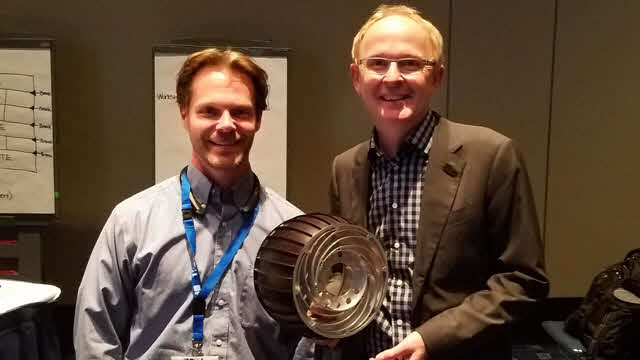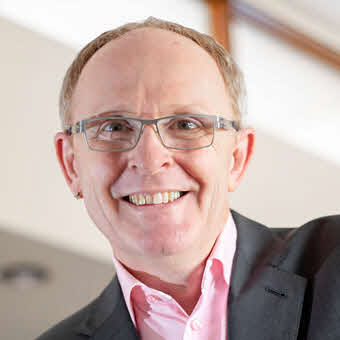Episode 410: How NASA Manages its Annual Plan and Portfolio (Free)
Download Project Management Professional (PMP)® training to your pocket:

NASA's Jet Propulsion Laboratory has worked with PMOs around the United States to define a "best practice" for creating and delivering an annual plan.
This interview with Darryl Hahn (LinkedIn Profile) was recorded at the stimulating Project Management Institute (PMI)® Global Conference 2017 in Chicago, Illinois.
Our interview presents both strategic and tactical approaches for uncovering your organizations' goals and objectives and for creating the prioritized list of achievable projects. We also examine ways of categorizing and classifying types of work, identifying and weighting priorities and adjusting the completed plan for when it collides with real life.
Episode Transcript
Below are the first few pages of the transcript. The complete transcript is available to Premium subscribers only.
Podcast Introduction
Male Voice: In this episode of the Project Management Podcast™, we discuss how NASA’s Jet Propulsion Laboratory and other top federally-funded research and development centers prioritize and monitor annual plan and portfolios.
Podcast Interview
Cornelius Fichtner: Hello and welcome to the Project Management Podcast™ at www.pm-podcast.com. I am Cornelius Fichtner. We are coming to you live from the stimulating 2017 PMI® Global Conference in Chicago where I am currently sitting in a completely empty presentation room—it’s Room W180 and the presenter who will be speaking here in about nineteen minutes is Darryl Hahn, sitting with me here. Hello Darryl.
Darryl Hahn: To a completely empty room.
Cornelius Fichtner: We don’t know that. Oh, somebody just walked in the door so we have at least one person who will be listening to you, Darryl. How are you enjoying the conference so far?
Darryl Hahn: Oh, pretty well. We didn’t get a chance to see a whole lot of presentations yet. We flew in from California last night. We’re actually flying out tonight right after this one. It’s Halloween weekend so I got to get back to the kids so we can go trick or treating.
Cornelius Fichtner: Yeah, that’s also important. Is this your first conference?
Darryl Hahn: No, no. I’ve been to a couple of these. Went to the Gartner ones. I’ve been to a bunch of the other different conferences as well. We went to the PMI® one last year.
Cornelius Fichtner: And when you compare the PMI® to the others—this is specifically for project managers. Do you feel more at home here as a project manager, program manager than you feel at the others?
Darryl Hahn: I think that’s –that maybe a safe bet to say. It’s certainly more specialized to specifically project management stuff that people are interested in in that expertise so there’s usually a bit more specifics to do here than there are in some of the other ones maybe.
Cornelius Fichtner: Yeah, What prompted you to talk about and to speak about the topic of the methods and madness to strategic planning—it doesn’t sound like the sexiest of topics.
Darryl Hahn: No. One of the things that we do at JPL is we chair the Project Management working groups session of all the FFRDCs. FFRDCs are federally-funded research and development facility. We are a full NASA center. There are a bunch of other NASA centers—Ames, Kennedy, a bunch of other ones but we sit down with those folks on a continuing basis and for lack of a better phrase, we share our pain. “Hey what are the other issues that you guys are having today? How do you guys figure out how to attract resources better than anybody else? What are you guys doing when your annual planning blows up and what are the sort of methods that you guys employ to get back on track”—those types of things.
We found a lot of value in collaborating with some of the other FFRDCs and we decided that each of the FFRDCs do things a little bit differently but they all—since they’re all FFRDCs, they do things kind of the same way as well. So we decided to sit down and work with some of the other guys and other teams and come up with basically consolidated version of how everybody does that and then be able to share that with everybody else.
One of the key things that we do as an FFRDC is Education Outreach—it’s very important to NASA and all the other NASA centers so we want to make sure that we’re trying to push out as much information as we can.
Cornelius Fichtner: Let’s take a step back. Everybody has heard about NASA and the JPL but not everybody may be completely familiar with what you’re doing. Give us sort of a 10,000 ft. overview. What does JPL do?
Darryl Hahn: JPL’s primary focus is unmanned deep space. So, satellites, rovers—those types of things. We don’t put a person on it—it’s you put your project together –for lack of a better phrase and you send it away realistically forever. Once it physically leaves the planet, you can’t get to it anymore and do stuff with it. So, a lot of the Project Management sort of characteristics that people are really relying on need to be super fine-tuned because it’s not like we can just go re-do something after our product hits the market—for lack of a better phrase. Once it’s gone, it’s gone.
So we have to really refine a bunch of those things. And you know, like I said, unmanned deep space so all the Mars Rovers, the Mars Exploration—not Mars Exploration Rover, not this one. It’s the Rover, the MSL, the Mars Science Lab, the Mars Reconnaissance Orbiter. We have a couple of earth-orbiting satellites as well –the two other and those kinds of things, but for the most part, it’s unmanned deep space..
Cornelius Fichtner: OK. You are in the PMO at JPL, right? What is your role in the PMO?
Darryl Hahn: I run the Project Management Office for the office of the CIO so it’s really the IT-PMO. The flight project side has another sort of PMO; it’s called the Project Support Office. The Project Support Office ones, basically PMO type stuff for the flight projects. They handle the reviews, you get called in front of Congress—that’s what those guys did to help you get through that sort of thing. I need to justify another $200M on my project—that’s those guys. I get the IT stuff. JPL is basically a line organization—excuse me—it’s a matrix organization where there’s flight projects and then there’s a line organization. The only reason JPL is there is for the missions—the flight side. All the line organizations support the flight side. My PMO does everything for the line organizations specifically in the IT area.
Cornelius Fichtner: OK. And you mentioned that you work with other PMOs from other federal agencies, right? How do you work together with them?
Darryl Hahn: We have at least quarterly either virtual sessions or we actually get together all. All the FFRDCs have a quarterly CIO gathering. So all of the CIOs tend to gather at one of the different centers whether it’s APL, Applied Physics Lab or MIT or Aerospace RAND, any of those other places.
At the CIO’s gathering, we try and piggyback on to that because we know the relevant people are going to be available or at those sessions so we either try or visit at the same time. And either do a day before or a day after or just a virtual session. And that happens at least once every quarter. Every month we try and get together for calls just to share the pain –“What are you guys doing? You learned anything new? Anybody seeing presentations that they’re enjoying? What did you learn from that?” –those kinds of things.
Cornelius Fichtner: What is on your annual plan?
Darryl Hahn: We’ve got all kinds of stuff on our annual plan. Specifically I want to talk about today is the IT annual plan obviously so it’s things like networking, it’s things like cyber security enhancements. It’s things like that the business needs that IT can help with so we need to improve our hiring process. What does that mean? Once we define that, we extract the IT components out of that and we decide whether or not they are valuable IT projects that we can put on our annual plan that will help support the business’ needs.
Cornelius Fichtner: That actually brings out a very good point. We’re not just talking about space projects here that are on your annual plan. We’re talking about everything, right? Everything and anything that you may need to do as an organization is on your annual plan?
Above are the first few pages of the transcript. The complete PDF transcript is available to Premium subscribers only.
PDUs: Business Acumen, PDUs: Power Skills, Project Portfolio Management, PMI Global Conference, PMI Global Conference 2017

